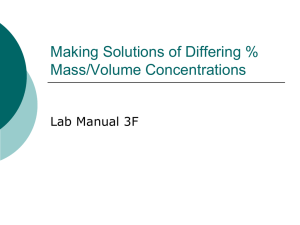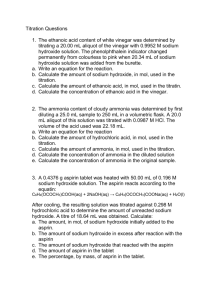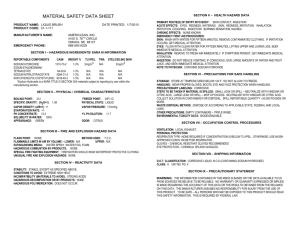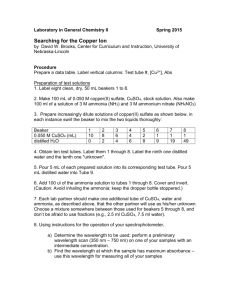EXPERIMENT 20
advertisement
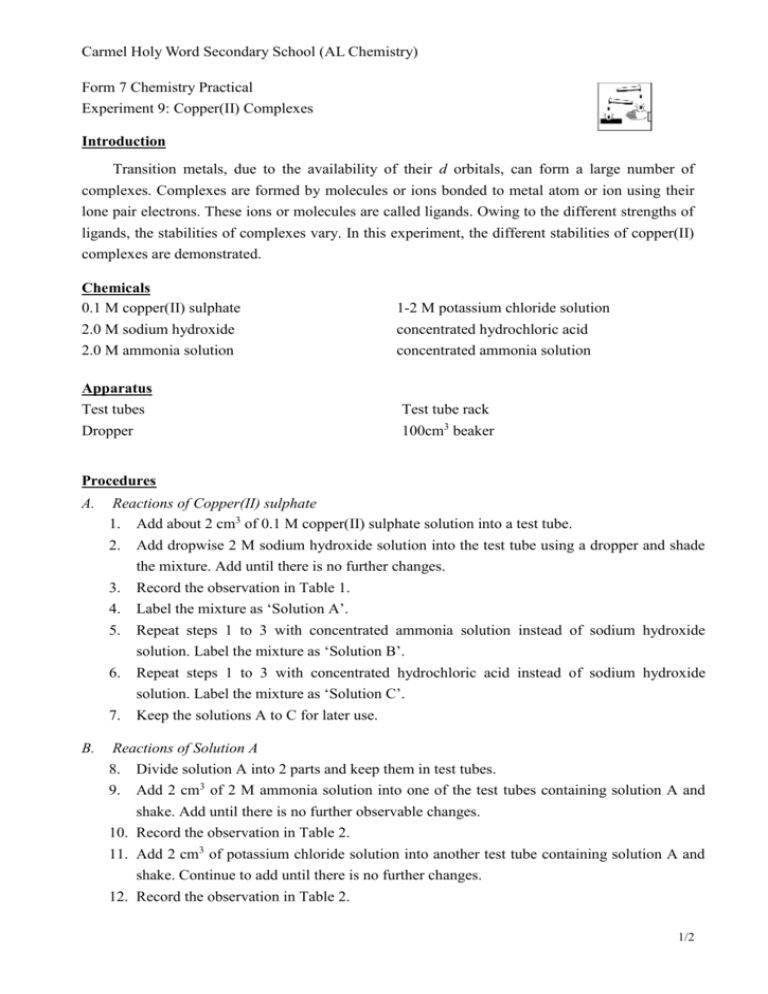
Carmel Holy Word Secondary School (AL Chemistry) Form 7 Chemistry Practical Experiment 9: Copper(II) Complexes Introduction Transition metals, due to the availability of their d orbitals, can form a large number of complexes. Complexes are formed by molecules or ions bonded to metal atom or ion using their lone pair electrons. These ions or molecules are called ligands. Owing to the different strengths of ligands, the stabilities of complexes vary. In this experiment, the different stabilities of copper(II) complexes are demonstrated. Chemicals 0.1 M copper(II) sulphate 1-2 M potassium chloride solution 2.0 M sodium hydroxide 2.0 M ammonia solution concentrated hydrochloric acid concentrated ammonia solution Apparatus Test tubes Dropper Test tube rack 100cm3 beaker Procedures A. Reactions of Copper(II) sulphate 1. Add about 2 cm3 of 0.1 M copper(II) sulphate solution into a test tube. 2. Add dropwise 2 M sodium hydroxide solution into the test tube using a dropper and shade the mixture. Add until there is no further changes. 3. Record the observation in Table 1. 4. Label the mixture as ‘Solution A’. 5. Repeat steps 1 to 3 with concentrated ammonia solution instead of sodium hydroxide solution. Label the mixture as ‘Solution B’. 6. Repeat steps 1 to 3 with concentrated hydrochloric acid instead of sodium hydroxide solution. Label the mixture as ‘Solution C’. 7. Keep the solutions A to C for later use. B. Reactions of Solution A 8. Divide solution A into 2 parts and keep them in test tubes. 9. Add 2 cm3 of 2 M ammonia solution into one of the test tubes containing solution A and shake. Add until there is no further observable changes. 10. Record the observation in Table 2. 11. Add 2 cm3 of potassium chloride solution into another test tube containing solution A and shake. Continue to add until there is no further changes. 12. Record the observation in Table 2. 1/2 Carmel Holy Word Secondary School (AL Chemistry) C. Reactions of Solution B 13. Divide solution B into two parts as in step 8 above. 14. Add 2 M sodium hydroxide solution into one of the test tubes containing solution B and shake. Continue to add until there is no more changes. 15. Record the observation in Table 2. 16. Add potassium chloride solution into another test tube containing solution B and shake. Add more solution there is no further changes. 17. Record the observation in Table 2. D. Reaction of Solution C 18. Divide solution C into two parts as in step 8 above. 19. Add 2 M ammonia solution into one of the test tubes containing solution C and shake. Continue to add until there is no more changes. 20. Record the observation in Table 2. 21. Add 2 M sodium hydroxide solution into another test tube containing solution solution C and shake. Go on adding the solution until there is no further changes. 22. Record the observation in Table 2. Data Treatment 1. Write down the observation of part A in Table 1. Chemicals mixed Observation Table 1 CuSO4(aq) + NaOH(aq) CuSO4(aq) + NH3(aq) CuSO4(aq) + HCl(aq) 2. Write down the observation of parts B to D in Table 2. Chemicals mixed Observation Table 2 A + NH3(aq) A + KCl(aq) B + NaOH(aq) B + KCl(aq) C + NH3 (aq) C + NaOH (aq) Questions 1. Write chemical equation(s) for the reaction between copper(II) sulphate and (a) sodium hydroxide. (b) ammonia solution. (c) hydrochloric acid. 2. Write all chemical equations for the reactions occurred in parts B to D. 3. According to the results, arrange the strength of the ligands H2O, NH3, Cl- and OH-in forming complexes with copper(II) ions in descending order. Explain briefly. 2/2


